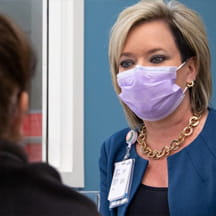Adapt care to a COVID landscape. We implemented drive-thru testing quickly around COVID and then a drive-thru flu clinic. Patients appreciate this option, so we are developing drive-thru treatment options for patients well into the future. Ten years of work got done in less than a month to activate and use new telehealth options and capacity.
We have deconstructed and reconstructed much of our entire hospital system as we determine how best to provide care for all in a COVID environment. As a result, we have a system with flex that can handle major shocks without requiring dramatic responses. Instead of having an on/off switch where we’re either able to do something or not, we have a dimmer switch that allows us to flow with the stresses and demands on our system to ensure we are providing care effectively and efficiently, even in a pandemic.
Avoid pandemic-related residual effects. Our goal is still to keep kids healthy and deliver remarkable care. Yes, children have been affected by COVID—but accidents and unintentional injuries are still the leading cause of death in children. We still have cancer; we still have neuro-development issues, and now we are experiencing unintended consequences around mental health, child abuse and neglect, and food insecurities as a result of social distancing, remote learning and unemployment.
Establish messaging to the community about the importance of being safe and staying home, while balancing that with not missing appointments and getting the help they need. Engage and leverage experts in the community and partner with organizations to meet the needs of underrepresented and underserved areas and to respond to new challenges that are a result of COVID.
Keep care teams engaged. Keep staff invested, energetic and enthusiastic about their work. Help people connect to the purpose and vision so they can understand the “why” when we ask them to stretch, change and be creative and innovative. Leader visibility is also a must.
Although we recognized a lot of work can be done remotely, people still value face-to-face interactions. People go into health care for a reason, and they go into pediatrics for a reason. It’s about providing support and eliminating distractions so they can continue to do what they do best. It is learning that the events of today will define our tomorrow. We must remind ourselves that we, as an organization and community, will come out stronger on the other side.


